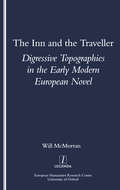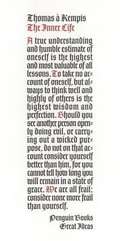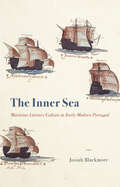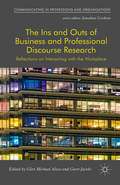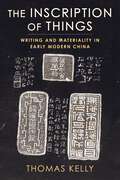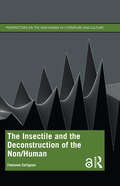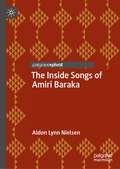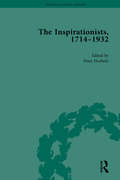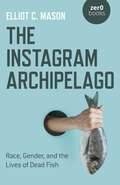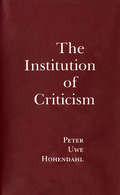- Table View
- List View
The Inn and the Traveller: Digressive Topographies in the Early Modern European Novel
by Will McMorran"In the landscape of the early modern European comic novel the inn often features as a monument to digression - the perfect setting for chance encounters with strangers who always have a story to tell. This wide-ranging comparative study explores the special part played by the inn, tracing the progress of a succession of wayward heroes and narrators in five canonical texts: Cervantes's ""Don Quijote"", Scarron's ""Roman comique"", Fielding's ""Joseph Andrews"" and ""Tom Jones"", Sterne's ""Tristram Shandy"" and Diderot's ""Jacques le fataliste"". As this celebration of digressive fiction unfolds, a very different picture emerges of the novel's rise and development."
The Inner Life
by Thomas À KempisThroughout history, some books have changed the world. They have transformed the way we see ourselves—and each other. They have inspired debate, dissent, war and revolution. They have enlightened, outraged, provoked and comforted. They have enriched lives—and destroyed them. Now, Penguin brings you the works of the great thinkers, pioneers, radicals and visionaries whose ideas shook civilization, and helped make us who we are. Penguin's Great Ideas series features twelve groundbreaking works by some of history's most prodigious thinkers, and each volume is beautifully packaged with a unique type-drive design that highlights the bookmaker's art. Offering great literature in great packages at great prices, this series is ideal for those readers who want to explore and savor the Great Ideas that have shaped the world. The Inner Life is taken from Thomas à Kempis's The Imitation of Christ, a classic Christian devotional that has taught and inspired generations. .
The Inner Life of Women in Medieval Romance Literature
by Jeff Rider Jamie FriedmanExploration of the emotionologies of several medieval, romance emotional communities through both fictional and non-fictional narratives. The contributors analyze texts from different linguistic traditions and different periods, but they all focus on women characters.
The Inner Sea: Maritime Literary Culture in Early Modern Portugal
by Josiah BlackmoreAn expansive consideration of how nautical themes influenced literature in early modern Portugal. In this book, Josiah Blackmore considers how the sea and seafaring shaped literary creativity in early modern Portugal during the most active, consequential decades of European overseas expansion. Blackmore understands “literary” in a broad sense, including a diverse archive spanning genres and disciplines—epic and lyric poetry, historical chronicles, nautical documents, ship logs, shipwreck narratives, geographic descriptions, and reference to texts of other seafaring powers and literatures of the period—centering on the great Luís de Camões, arguably the sea poet par excellence of early modern Europe. Blackmore shows that the sea and nautical travel for Camões and his contemporaries were not merely historical realities; they were also principles of cultural creativity that connected to larger debates in the widening field of the maritime humanities. For Blackmore, the sea, ships, and nautical travel unfold into a variety of symbolic dimensions, and the oceans across the globe that were traversed in the fifteenth and sixteenth centuries correspond to vast reaches within the literary self. The sea and seafaring were not merely themes in textual culture but were also principles that created individual and collective subjects according to oceanic modes of perception. Blackmore concludes with a discussion of depth and sinking in shipwreck narratives as metaphoric and discursive dimensions of the maritime subject, foreshadowing empire’s decline.
The Inner World of Gatekeeping in Scholarly Publication
by Pejman Habibie Anna Kristina HultgrenThis edited book focuses on the certifiers of scientific knowledge, bringing together experts in a variety of areas in Applied Linguistics to address the complex topic of editing and reviewing in writing for scholarly publication. Drawing on insider perspectives, the authors bring to the fore personal histories, narratives and first-hand accounts of editors and reviewers and help paint a richer and more nuanced picture of the discourses, practices, experiences, success stories, failures, and challenges that frame and shape trajectories of both Anglophone and English as an additional language (EAL) scholars in adjudicating and accrediting academic output. This book will be of interest to researchers, practitioners, supervisors, writing mentors, early-career scholars and graduate students in a variety of fields.
The Ins and Outs of Business and Professional Discourse Research: Reflections on Interacting with the Workplace (Communicating in Professions and Organizations)
by Glen Michael Alessi Geert JacobsWinner of the Association for Business Communication’s Distinguished Publication on Business Communication Award 2016This edited volume offers a collection of original chapters focusing on the Ins and Outs of professional discourse research. Drawing on insights from LSP, ethnography and discourse analysis, it covers a wide range of issues, ranging from gaining access and collecting data to feeding results back in the form of recommendations to practitioners.
The Inscription of Things: Writing and Materiality in Early Modern China
by Thomas KellyWhy would an inkstone have a poem inscribed on it? Early modern Chinese writers did not limit themselves to working with brushes and ink, and their texts were not confined to woodblock-printed books or the boundaries of the paper page. Poets carved lines of verse onto cups, ladles, animal horns, seashells, walking sticks, boxes, fans, daggers, teapots, and musical instruments. Calligraphers left messages on the implements ordinarily used for writing on paper. These inscriptions—terse compositions in verse or epigrammatic prose—relate in complex ways to the objects on which they are written.Thomas Kelly develops a new account of the relationship between Chinese literature and material culture by examining inscribed objects from the late Ming and early to mid-Qing dynasties. He considers how the literary qualities of inscriptions interact with the visual and physical properties of the things that bear them. Kelly argues that inscribing an object became a means for authors to grapple with the materiality and technologies of writing. Facing profound social upheavals, from volatility in the marketplace to the violence of dynastic transition, writers turned to inscriptions to reflect on their investments in and dependence on the permanence of the written word. Shedding new light on cultures of writing in early modern China, The Inscription of Things broadens understandings of the links between the literary and the material.
The Insectile and the Deconstruction of the Non/Human (Perspectives on the Non-Human in Literature and Culture)
by Fabienne CollignonThe Insectile and the Deconstruction of the Non/Human defines, conceptualizes, and evaluates the insectile—pertaining to an entomological fascination—in relation to subject formation. The book is driven by a central dynamic between form and formlessness, further staging an investigation of the phenomenon of fascination using Lacanian psychoanalysis, suggesting that the psychodrama of subject formation plays itself out entomologically. The book’s engagement with the insectile—its enactments, cultural dreamwork, fantasy transformations—‘in-forming’ the so-called human subject undertakes a broader deconstruction of said subject and demonstrates the foundational but occluded role of the insectile in subject formation. It tracks the insectile across the archives of psychoanalysis, seventeenth century still life painting, novels from the nineteenth century to the present day, and post-1970s film. The Insectile and the Deconstruction of the Non/Human will be of interest for scholars, graduate students, and upper-level undergraduates in film studies, visual culture, popular culture, cultural and literary studies, comparative literature, and critical theory, offering the insectile as new category for theoretical thought.
The Inside Songs of Amiri Baraka (Palgrave Studies in Music and Literature)
by Aldon Lynn NielsenThe Inside Songs of Amiri Baraka examines the full length of Baraka’s discography as a poet recording with musicians as well as his contributions to jazz and R & B, beginning with his earliest studio recordings in 1965 and continuing to the last year of his life, 2014. This recorded history traces his evolution from the era of Beat poetry and “projective verse,” through the period of the Black Arts Movement and cultural nationalism, and on to his commitments to “third world Marxism,” which characterized the last decades of his life. The music enfolding Baraka’s recitations ranges from traditional African drumming, to doo wop, rhythm and blues, soul and the avant garde jazz that was his great love and the subject of so much of his writing, and includes both in-studio sessions and live concert performances. This body of work offers a rare opportunity to think about not only jazz/poetry, but the poet in the recording studio and the relations of text to score.
The Insider's Guide to Book Publishing Success
by Eric Kampmann Margot AtwellThe publishing industry is changing rapidly, and there are more options for authors than ever before. Should you find an agent and search for a traditional publishing deal or consider self-publishing? Should you print hardcover copies or opt for an ebook-only launch? Should you hire a publicist? This easy-to-read, nuts-and-bolts guide covers everything from what to look for in? a contract to how many copies to print. Some of the topics covered are choosing a publishing strategy, the editorial process, design, printing, sales and distribution, marketing and publicity.?
The Insider's Guide to Getting an Agent
by Lori PerkinsPerkins delivers all the vital information on how to get the best representation for your work- the latest trends, how to target the right agents, potential of subrights, publicity and foreign sales and when it's time to make writing your day job.
The Insider's Guide to Inside No. 9: Behind the Scenes of the Award Winning BBC TV Series
by Mark SalisburyThe ultimate companion to unlock what lurks Inside No. 9Welcome, reader, to the experience of a lifetime: a behind-the-scenes tour of the remarkable Bafta award-winning series. This show-by-show guide reveals the genesis of each episode's idea through to the scripting, casting, design, direction, and production - where you'll have access to the minds and imaginations of creators Reece Shearsmith and Steve Pemberton.Filled with the show's dark humour and behind-the-scenes photographs, production stills, mood boards and concept drawings, you'll find yourself delighted and disturbed in equal measure. Every episode from the first five series will be covered by interviews with key creatives and discussion of the inspiration and creation behind every moment.Are you ready to step through the door marked No. 9?
The Insider's Guide to Technical Writing
by Krista Van LaanEvery complex product needs to be explained to its users, and technical writers, also known as technical communicators, are the ones who do that job. A growing field, technical writing requires multiple skills, including an understanding of technology, writing ability, and great people skills. Whether you're thinking of becoming a technical writer, just starting out, or you've been working for a while and feel the need to take your skills to the next level, The Insider's Guide to Technical Writing can help you be a successful technical writer and build a satisfying career. Inside the Book Is This Job for Me? What does it take to be a technical writer? Building the Foundation: What skills and tools do you need to get started? The Best Laid Plans: How do you create a schedule that won't make you go crazy? How do you manage different development processes, including Agile methodologies? On the Job: What does it take to walk into a job and be productive right away? The Tech Writer Toolkit: How do you create style guides, indexes, templates and layouts? How do you manage localization and translation and all the other non-writing parts of the job? I Love My Job: How do you handle the ups and downs of being a technical writer? Appendixes: References to websites, books, and other resources to keep you learning. Index
The Insider: Malcolm Cowley and the Triumph of American Literature
by Gerald HowardA finalist for the 2026 Andrew Carnegie Medal for Excellence in NonfictionA delightful and majestic reckoning with the ascent of American fiction in the twentieth century through the prism of the under-known man who had an astonishing amount to do with itMalcolm Cowley is not a household name today, but the American literary canon would look very different without him. A prototypical &“man of letters&” of his generation—Harvard University, a volunteer in the French ambulance corps in World War I, a rite of passage in Paris after the war—he became one of the few truly influential critics of the 1920s and &’30s, along with his close New Republic colleague Edmund Wilson. Cowley&’s early support of Hemingway, Fitzgerald, and their set—and indeed for framing this group in generational terms in the first place—secured his place in literary history.Most people are lucky to be part of a single game-changing era in their careers; for Cowley, it happened again and again. After emerging from the political fray of the thirties badly damaged, he retreated behind the scenes as a tastemaker whose import has awaited Gerald Howard to be brought into full view. The process of canon formation is a murky business, and Cowley was a prime mover in it for the better part of four decades, through the Lost Generation, the Beat Generation, and the counterculture of the sixties. Without him, the odds would be much longer that the names William Faulkner, Jack Kerouac, and Ken Kesey, to name just three, would have ever echoed.In The Insider, Gerald Howard gives an intimate accounting of the fever graph of a fascinating and multifaceted career in the literary trade that uses that career to tell a much bigger story of how American literature took the course that it did from the 1920s to the 1960s. It&’s a story of an art form, and an industry, and a country experiencing wrenching change, and the people who made a home in the storm and in no small part shaped it. Howard&’s own career as a literary weathermaker is justly acclaimed, and he has brought all his talents of head and heart to bear in crafting this extraordinary book. It&’s a gift to booklovers and a major contribution to the cultural history of this country.
The Insistence of Art: Aesthetic Philosophy after Early Modernity
by Paul A. KottmanPhilosophers working on aesthetics have paid considerable attention to art and artists of the early modern period. Yet early modern artistic practices scarcely figure in recent work on the emergence of aesthetics as a branch of philosophy over the course the eighteenth century. This book addresses that gap, elaborating the extent to which artworks and practices of the fifteenth through the eighteenth centuries were accompanied by an immense range of discussions about the arts and their relation to one another.Rather than take art as a stand-in for or reflection of some other historical event or social phenomenon, this book treats art as a phenomenon in itself. The contributors suggest ways in which artworks and practices of the early modern period make aesthetic experience central to philosophical reflection, while also showing art’s need for philosophy.
The Inspirationists, 1714 - 1932 Vol 3 (American Communal Societies Ser.)
by Peter HoehnleThe Community of True Inspiration, or Inspirationists, was one of the most successful religious communities in the United States. This collection offers a broad variety of Inspirationist texts, almost all of them translated from German and published here for the first time.
The Inspirationists, 1714-1932 Vol 1 (American Communal Societies)
by Peter HoehnleThe Community of True Inspiration, or Inspirationists, was one of the most successful religious communities in the United States. This collection offers a broad variety of Inspirationist texts, almost all of them translated from German and published here for the first time.
The Inspirationists, 1714-1932 Vol 2 (American Communal Societies Ser.)
by Peter HoehnleThe Community of True Inspiration, or Inspirationists, was one of the most successful religious communities in the United States. This collection offers a broad variety of Inspirationist texts, almost all of them translated from German and published here for the first time.
The Instagram Archipelago: Race, Gender, and the Lives of Dead Fish
by Elliot C. MasonSet on Idan Hayosh&’s peculiar Instagram page of women holding dead fish, The Instagram Archipelago is a conversation with contemporary culture&’s logics of gender and race. Working through recent thinking in Black studies and Hayosh&’s satirical images, Elliot C. Mason presents the aesthetics of capitalism as a sea that makes everything the same, turning the world into a single form. The Instagram Archipelago brings radical antiracist and feminist scholarship to a general audience, applying a model of thinking beyond gender and race to the strange world of online fishing photos. This funny and fascinating book moves past the liberal celebration of gender and race, towards a tiny island of resistance in a growing archipelago.
The Instant World Report: Canada's Role in Shaping the Right to Communicate (Global Transformations in Media and Communication Research - A Palgrave and IAMCR Series)
by Aliaa DakrouryThis book proposal focuses on Canada's pioneering role in shaping the international understanding of the right to communicate, particularly through the Canadian Telecommission Studies of 1969. The study argues that the 1971 Instant World report, a landmark document, has been overlooked in the existing literature despite its importance in the history of conceptualizing and implementing this human right. The project aims to fill this gap by exploring the historical context of the report and analyzing its contents, shedding light on themes like privacy and indigenous communication rights. Additionally, the manuscript highlights the unique contribution of Betty Zimmerman, the only female Canadian member of the MacBride Commission in 1977, replacing Marshall McLuhan. Zimmerman's insights become pertinent not only for scholars interested in the New World Information and Communication Order but also for feminist studies, showcasing a leading female figure's role in Canadian communication and cultural policy. The research promises a novel and untold perspective on the history of the right to communicate, addressing gaps in international and Canadian communication, women’s studies, and media policy literature.
The Institution of Criticism
by Peter Uwe HohendahlGerman radicals of the 1960s announced the death of literature. For them, literature both past and present, as well as conventional discussions of literary issues, had lost its meaning. In The Institution of Criticism, Peter Uwe Hohendahl explores the implications of this crisis from a Marxist perspective and attempts to define the tasks and responsibilities of criticism in advanced capitalist societies. Hohendahl takes a close look at the social history of literary criticism in Germany since the eighteenth century. Drawing on the tradition of the Frankfurt School and on Jürgen Habermas’s concept of the public sphere, Hohendahl sheds light on some of the important political and social forces that shape literature and culture. The Institution of Criticism is made up of seven essays originally published in German and a long theoretical introduction written by the author with English-language readers in mind. This book conveys the rich possibilities of the German perspective for those who employ American and French critical techniques and for students of contemporary critical theory.
The Institution of Theory
by Murray KriegerOriginally published in 1994. In The Institution of Theory, Murray Krieger examines, at once sympathetically and critically, the process by which theory has become institutionalized in the American academy and the consequences of theory as an academic institution. He traces the transformation of literary theory into critical theory and relates it to changes in the place of literature within questions about discourse at large. And he faces the costs as well as the gains of the recent denial of privilege to the literary. To support his view of the issues at stake in current theoretical debates, Krieger surveys both the history of American criticism and the general history of literary theory in the West. He sees divisions in each of them that foreshadow the current debates: in the first a conflict between the social and the aesthetic functions of literature, and in the second a conflict between the treatment of literature as a reflection of a culture's ideology and the treatment of literature as a subversion of that ideology. To what extent, he asks, are our debates new and to what extent are they merely refashioned versions of those we have always had?
The Institutional Development of Podcasting: From Participatory Practice to Platform Content (Disruptions)
by Aske Kammer Thomas Spejlborg SejersenReferring back to the early 2000s, this book traces the development of podcasting from a “do-it-yourself” medium by amateurs into its current environment, where a wide variety of individuals, organizations, and platforms operate in an increasingly crowded and competitive market.Through original case studies of shows and platforms including "The Daily" and Spotify, the authors explore the processes and effects of commercialization, platformization, and datafication in the industry. Drawing on institutional theory and the growing body of scholarly literature about podcasting, they examine the shifts and reorientations in institutional logics that characterize podcasting and present the different types of actors that operate in the commercial and noncommercial podcast markets.The Institutional Development of Podcasting will be of interest to advanced students and researchers of audio media, journalism, and media industries.
The Institutions Changing Journalism: Barbarians Inside the Gate
by Patrick FerrucciBringing together original contributions from a worldwide group of scholars, this book critically explores the changing role and influence of institutions in the production of news. Drawing from a diverse set of disciplinary and theoretical backgrounds, research paradigms and perspectives, and methodologies, each chapter explores different institutions currently impacting journalism, including government bodies, businesses, technological platforms, and civic organisations. Together they outline how cracks in the autonomy of the journalism industry have allowed for other types of organizations to exert influence over the manner in which journalism is produced, funded, experienced and even conceptualized. Ultimately, this collective work argues for increased research on the impact of outside influences on journalism, while providing a roadmap for future research within journalism studies. The Institutions Changing Journalism is an invaluable contribution to the field of journalism, media, and communication studies, and will be of interest to scholars and practitioners alike who want to stay up to date with fundamental institutional changes facing in the industry.
The Insult Dictionary
by Julie TibbottDo you long for the days when a jerk was a "cad"? Want to tell that "swillbelly" to clean up his table manners and that grumbling "glump" to stop whining? Would you like a way of saying simpleton that's not quite so simple--"ninnyhammer," perhaps?All this nastiness and more can be found in the pages of this fun reference book. With insults ranging from Roman times (lutum lenonium = filthy pimp) and Shakespearean snipes (I'm talking to you, you knotty-pated fool) to salty pirate-speak and Wild West zingers, you're sure to find an insult for everyone, be they a helminth (a parasite in Ancient Greece) or a swinge-buckler (an Elizabethan braggart).Chapters are organized chronologically by historical period--Ancient Attacks, Medieval Madness, Edgy Elizabethans, Victorian Venom, Jazz Age Jibes, and Cold War Cuts--and include themed sidebars focusing on Pirate Put-Downs, Hobo Huffs, and Cowboy Curses, as well as samplers for words with many different sayings per period. Fun, a little bit lewd, and incredibly informative this is a must-read for humor fans, history buffs, armchair etymologists, and the most sneaping of breedbates.
